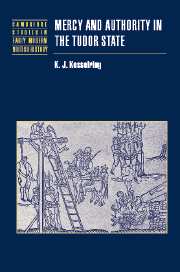Book contents
- Frontmatter
- Contents
- Acknowledgments
- Abbreviations and conventions
- 1 Introduction: mercy and the state
- 2 Changing approaches to punishment and mitigation
- 3 Changing approaches to the pardon
- 4 Patronage, petitions, and the motives for mercy
- 5 Public performances of pardon
- 6 Protest and pardons
- 7 Conclusion
- Appendix I Sources
- Appendix II Benefit of the belly
- Bibliography
- Index
- Titles in the series
Appendix I - Sources
Published online by Cambridge University Press: 05 July 2009
- Frontmatter
- Contents
- Acknowledgments
- Abbreviations and conventions
- 1 Introduction: mercy and the state
- 2 Changing approaches to punishment and mitigation
- 3 Changing approaches to the pardon
- 4 Patronage, petitions, and the motives for mercy
- 5 Public performances of pardon
- 6 Protest and pardons
- 7 Conclusion
- Appendix I Sources
- Appendix II Benefit of the belly
- Bibliography
- Index
- Titles in the series
Summary
Charters of pardon were issued as letters patent under the Great Seal. An explanation of the procedures involved in the production of such charters provides a necessary grounding for the discussion of sources that follows.
At the beginning of the Tudor period, the king's approval of a petition initiated the formal process. By about 1535, however, the king or queen's attorney and solicitor would first have to sign the back of any petition, and either attach or write onto the document itself a summary of its contents. The king or queen might sign the bill, in which case it could serve as an immediate warrant and be carried directly to Chancery. The use of immediate warrants was eventually curtailed: Queen Elizabeth ordered that signed bills be directed through all the relevant offices like any other warrants. She did, however, make allowance for petitions requiring speedy action – which included some pardons – and noted that if the signed bill was endorsed by the Lord Treasurer and two or three other members of the Council it could still serve as an immediate warrant.
Otherwise, the approved petition was sent to the Secretary's office, where clerks wrote under the signet to the Keeper of the Privy Seal, first keeping the bill they received as their warrant and making a note of the document being sent forward.
- Type
- Chapter
- Information
- Mercy and Authority in the Tudor State , pp. 209 - 211Publisher: Cambridge University PressPrint publication year: 2003



